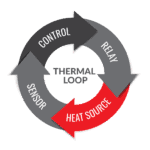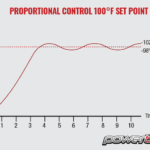*Note – This is the 6th and final installment in our Thermal Loop Series. See the bottom of this article for previous installments.
What Are the Different Types of Temperature Sensors?
There are a wide variety of pipeline temperature sensors. Each style, no matter how it is made or configured, is absolutely critical in the discussion of an efficient thermal loop.
Pipeline temperature sensors can come in the form of a RTD, Thermocouple, Thermistor or even a mercury filled bulb and capillary tube. Configurations can be as small and thin as a human hair, or larger than your arm. No matter the style or mechanical design, if the sensor is not placed in the proper location, your application will not work.
How do Temperature Sensors work?
In each case no matter which type of sensor you choose to use in your application, the internals of that sensor change state with rising or falling temperatures. A thermocouple, for example, utilizes two dissimilar wire types that when introduced to temperature will put out a specific low voltage signal. Type J thermocouples for example will use an iron and constantan wire.

Type J thermocouples can reliably sense up from around -40 F to about 1300 F depending on the mechanical construction of the housing. RTD’s are similar: as temperature changes, the resistance of the sensor changes.

And so it is also with thermistors or mercury-filled bulbs and capillaries.
Probing Steaks
Here’s another example: let’s step outside and cook a nice juicy steak. For this scenario, we have the latest and greatest pellet grill. Get that grill to the right temperature, season up your steak, and throw it on the grill. Deciding on what temperature you want to cook your steak is the best way to ensure the perfect cook on your meat. These new pellet grills have sensor probes that you can stick right into your steak. You can go inside and monitor it on the couch while watching your favorite show.
To continue with this example, let’s say we put that temperature probe on the grill next to the steak. The probe is sitting at at least 350 F, and the perfect temperature you are looking for on your steak is 140 F. You wouldn’t be watching your show very long, would you? That probe would sense 140 F right away, and signal you that the steak is done. The probe belongs in the meat.
From Pipe Temperature Sensors To Tanks
Just as with a tank of product needing to be heated. A flowing process needs to be sensed. Where a pipe sensor is placed is critical in the function or process that you are trying to achieve. Many people place the temperature sensor at the top of the tank. As soon as your tank product drains down, your temperature sensor is just sensing air. The heater in the thermal loop is responding to and heating to air temperature, not product temperature. This is a quick way to burn up your heater.
In a flowing process of natural gas for a fuel gas preheater, placing the sensor right at the outlet of the heater will ensure the most optimal gas temperature. Many installations like to see that temperature sensor way downstream at the injection point to the turbine. This causes a great deal of thermal lag and cycling of the heater.
Freeze protection applications work best when the sensor providing the signal to the control system is way up in the air, ideally on the north side of the facility, which is usually the first place to possibly see cold temperatures. You’ll see a significant difference in sensing ability here than mounting your external pipe temperature sensor down inside the facility or behind “hot” or warm equipment.
The Thermal Loop Series
1- All About the Thermal Loop
2- What is a Temperature Controller and How Does It Work?
3- PID Controllers
4- On/Off Controls and the Thermal Loop
5- Proportional Control in the Thermal Loop
Pipe heaters from Powerblanket keep your fluids flowing all year long, providing freeze protection for your entire system.




